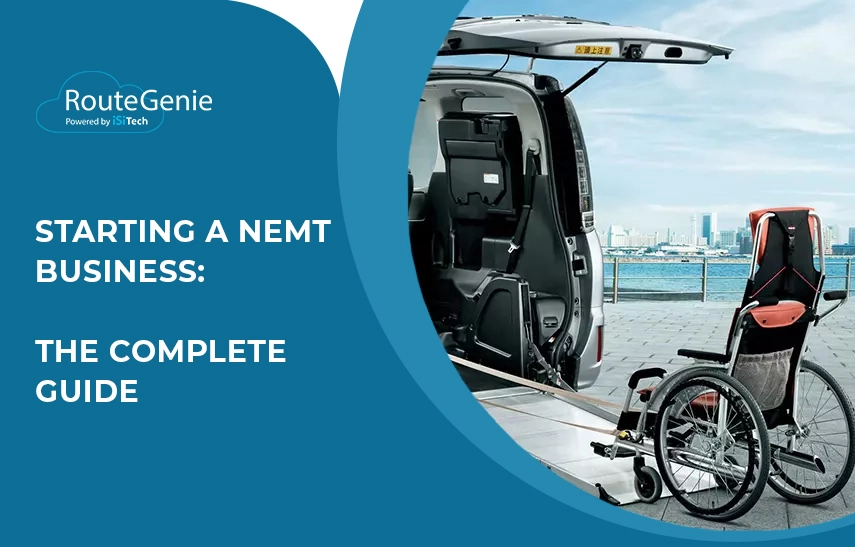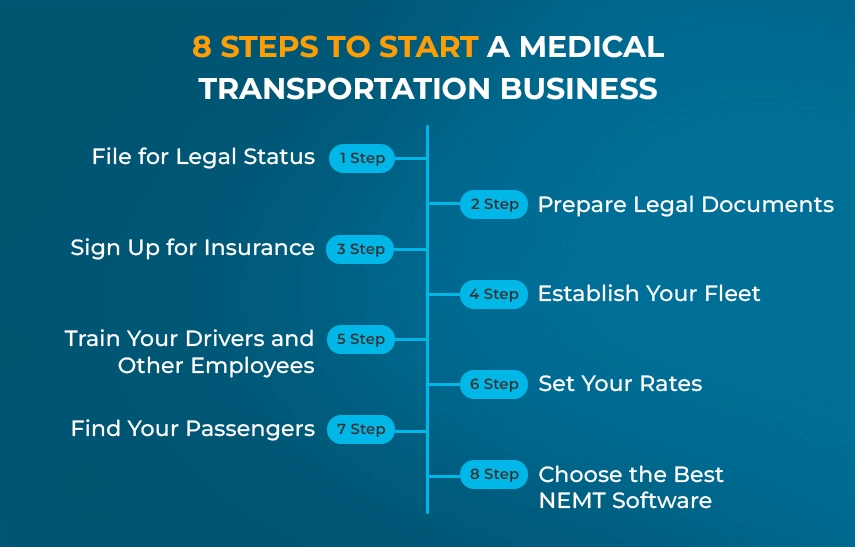Starting an NEMT Business: the Complete Guide

Starting your own non-emergency medical transportation company may seem like a daunting task. However, when you take the process step-by-step, it’s achievable for anyone with a willingness to learn and work hard to create a successful business.
More than 4 million Americans miss or delay their healthcare appointments every year due to a lack of adequate transportation. This is a staggering figure, especially when you consider the important appointments that are missed—dialysis or chemotherapy sessions, vaccinations, routine checkups, lab tests, rehab sessions, pharmacy pickups, dentist visits, and more.
Luckily, Medicaid beneficiaries have the opportunity to receive rides, if eligible, to and from their medical appointments safely. This benefit is known as non-emergency medical transportation services.
NEMT is a rapidly growing industry. Elderly and disabled folks across the nation need reliable transportation. By 2034, seniors will outnumber children, so starting a non-emergency medical transportation business is a worthwhile venture with great growth potential, no matter where you’re located.
Unsure where to begin? No problem. We’ve created a complete guide to starting your own NEMT business from the ground up. Read on to learn about basic requirements, approximate start-up costs, business structure, and other useful tips and tricks to learn how to start a transportation company.
Contents:
- The Сost of Starting Your NEMT Business
- Step 1. File for Legal Status
- Step 2. Prepare Legal Documents
- Step 3. Sign Up for Insurance
- Step 4. Establish Your Fleet
- Step 5. Train Your Drivers and Other Employees
- Step 6. Set Your Rates
- Step 7. Find Your Passengers
- Step 8. Choose the Best NEMT Software
The Сost of Starting Your NEMT Business
How much money do you need to start a medical transport business? If you are initially starting with a single vehicle and intend to use your personal van or a rental for ambulatory NEMT, then the startup budget can be rather low. You will not get away with zero investment, but the cost of entering the medical transportation field can be as low as $4000 to $5000. This number stems from a variety of factors—registering the business, covering legal fees, finding a suitable facility, signing up for insurance, purchasing permits and licenses, equipping the vehicle, paying utility bills and wages, launching a website, and marketing your business, among other things.
If you’re starting small, don’t worry about finding a huge office space. Operate out of your home, if possible, and see if your friends and family would be willing to help with management and behind-the-scenes work so you can focus on building relationships with clients and completing trips. These small adjustments can help reduce costs and increase the amount you have in your pocket.
On the other hand, if you are looking to acquire an NEMT franchise or intend to buy a large number of fully equipped, brand-new NEMT vehicles for your fleet, then some estimate that successfully launching an NEMT company costs from tens to hundreds of thousands of dollars.
Starting any business requires a lot of planning and preparation since you have to know what you are going to do and what your go-to-market strategy is. If you are already looking for guidance to start an NEMT business, we can assume that you have already conducted the market research and studied the competition. We've outlined 8 crucial steps to start the NEMT business.
Step 1. File for Legal Status
One of the first things you should do when you start a business is figure out what your legal status will be. Typically, you will be a sole proprietorship, an LLC, or a partnership. Each status comes with its advantages and disadvantages, so understanding what you want out of your business and what your structure might look like is a good place to start.
It is common knowledge that a sole proprietorship requires fewer accounting expenses and has simpler administration procedures. However, sole proprietors are liable with their personal assets for any debts or legal claims against the business, which can pose a significant risk. In contrast, forming an LLC (Limited Liability Company) offers personal liability protection, separating your personal assets from business obligations. This business structure still allows flexible management and pass-through taxation. Partnerships are ideal when multiple individuals want to share ownership and responsibilities. However, be mindful that they still entail personal liability and require clear agreements to manage profit sharing and dispute resolution.
Alternatively, NEMT businesses can be registered as an S corporation or a C corporation, but these legal structures are rather complex and would fit only if you plan to rapidly expand. It’s important to sit down with a lawyer and discuss your options so that you can choose the status that’s best for your situation.
Step 2. Prepare Legal Documents
Preparing and filing your legal documents correctly is crucial to a successful start of your business. This includes filling out and submitting non-emergency medical transportation licenses (varies from state to state), certificates, and permits that will legally allow you to operate. It’s important to note that requirements vary based on the state and city you’re working in. Whether you’re located in Michigan, California, Texas, Georgia, or New York, there will be regulations specific to your locale. You should begin by filling out a medical transportation provider application package at your local Department of Motor Vehicles.
Step 3. Sign Up for Insurance
In order to run your business, you’ll have to insure both your vehicles and your drivers. The price you pay depends on a number of factors, including anything from driver experience and history to types of vehicles in your fleet and how many trips you complete in a day. Understanding what factors impact NEMT insurance cost is important so you can eventually adjust and work to lower it. Many providers require training courses for their drivers to decrease insurance prices.
Step 4. Establish Your Fleet
Once you have all your paperwork completed, it’s time to build your fleet. It’s important to find vehicles for your NEMT business that are reliable, safe, and customizable for passengers’ unique needs. The type of NEMT vans you will be operating depends on your budget and willingness to specialize. All vehicles should be ADA compliant. Additionally, if you want to get access to a broader range of contracts, it is advisable to equip your van with wheelchair ramps or lifts, four-point tie-down systems as well as lap and shoulder belts, side entry, stretchers, oxygen tanks, walkers, and anything else your passengers may need. This shows the government that you’re prepared for all types of trip situations and have the tools to accommodate a variety of passengers.
Step 5. Train Your Drivers and Other Employees
If you do not plan to run a one-man operation, then your next step would be to hire professional drivers and other support staff like dispatchers, billers, an accountant, an office manager, etc. Your NEMT business's success heavily depends on the quality of your team. Hire drivers with clean driving records and train them thoroughly in both technical skills, software use, and compassionate care. An advantage would be to get your drivers CPR and first aid certified and teach them proper techniques to assist passengers with various mobility challenges. Beyond driving skills, focus on customer service training - your drivers are the face of your company and often interact with vulnerable patients who may be anxious or uncomfortable.
For office staff, provide comprehensive training on HIPAA compliance, scheduling protocols, and insurance verification. Everyone on your team should understand the importance of on-time performance, professionalism, and patient confidentiality. Consider implementing regular training refreshers and performance evaluations to maintain high service standards and reduce your liability risks and insurance costs.
Step 6. Set Your Rates
Once you have your fleet in place, it's time to set your NEMT rates. It's important to research the rates of other NEMT providers in your area to ensure that you are offering competitive prices. You should also take into account the cost of gas, maintenance, and insurance, as well as your desired profit margin. It's recommended to offer different pricing options for different types of trips, such as one-way or round-trip fares, and establish policies for driver wait time and passenger no-shows. By setting fair and competitive rates, you'll not only attract more clients but also establish a reputation as a reliable and affordable NEMT provider.
Step 7. Find Your Passengers
If potential clients don’t know your business exists, they can’t book a trip. This means you need to market your business, and market it well. No matter whether you want to scale your NEMT business or just starting it. Reach out to all of the NEMT brokers that operate in your area to sign long-term contracts. Additionally, contact nursing homes, assisted living facilities, retirement communities, and hospitals in your area to see if you can strike a direct deal for regular transport. Hang up flyers in grocery stores and local businesses where your target group shops if you want to attract private-pay customers. And, of course, create an informative website and implement social media marketing tactics. When you develop your online presence, keep in mind that the majority of your clients are elderly and disabled folks, so it’s important to make your site both accessible and user-friendly.
Step 8. Choose the Best NEMT Software
The NEMT field is going through a rapid digitization process which puts additional requirements on transportation providers. Many state Medicaid programs and local brokers demand the use of specialized software solutions. NEMT software is ground-breaking technology that automates all aspects of your NEMT operation, including dispatching, scheduling, routing, billing, driver management, customer notifications, and more. It tackles daily challenges like traffic problems, vehicle breakdowns, driver call-offs, cancellations, no-shows, and on-demand trips, among other things. In addition, the software simplifies billing to reduce errors and allow for faster reimbursement times.
If you’re looking for a top-notch, modern platform, RouteGenie is the way to go. Now that you’ve read our guide, it’s time to create your very own NEMT business plan and start a non-emergency medical transportation business. No matter where you’re located or how many vehicles you plan to operate with, we hope these steps help you get started!